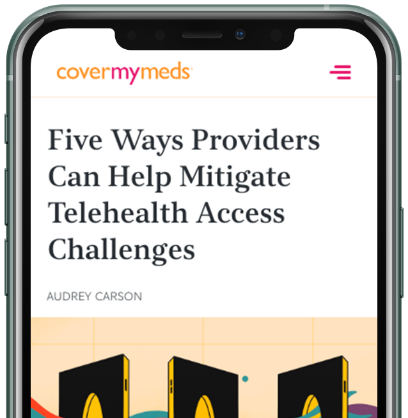At the Top of Patients’ Wish Lists is Price Transparency
One of the most important factors on patients’ minds is affordability of care.

According to a recent McKinsey study, 72 percent of consumers are concerned about at least one kind of healthcare expense, be it related to health insurance, routine medical procedures, end-of-life care or otherwise.Healthcare consumerism 2018: An update on the journey
As it pertains to prescriptions, patients carry these affordability concerns from their providers’ offices to the pharmacy. More often than not, patients aren’t aware of the cost of therapy when their providers prescribe it, leading to sticker shock at the pharmacy and the patient potentially leaving without their medication.
Prescription abandonment is a huge problem affecting patient outcomes and the healthcare industry’s expenditures. The path forward is to address the patient’s need for price transparency at the point of prescribing.
Better patient outcomes depend on price transparency
Patients who are prescribed a medication at their provider’s office typically have little insight into what they’ll encounter when they pick up their medications at the pharmacy. There is often no discussion with providers around medication costs, generic options, if a prior authorization is required, or if they qualify for assistance programs. Often, this is because the doctor simply doesn’t have visibility into this information.
When patients arrive at the pharmacy to pick up their medications, they may be shocked to know that their prescription is far out of their price range, or unavailable until a prior authorization is completed and approved.
This phenomenon isn’t uncommon. According to a recent report from CoverMyMeds, 75 percent of patients have received a prescription that cost more than they anticipated.2018 Real-Time Benefit Check National Adoption Scorecard So, what happens when patients realize they can’t afford their medications? They may opt not to fill the prescriptions, which could have a negative impact on their health, resulting in additional unplanned visits to the emergency department and hospitalizations.The Cost of Not Taking Your Medicine
Another risk is that patients will decide to fill the expensive prescription once, but abandon subsequent treatment against their doctors’ recommendations due to accumulated costs. This scenario has happened to 37 percent of patients in a recent survey.2018 Real-Time Benefit Check National Adoption Scorecard This too can result in additional complications and an overall increase in cost of care.
Patients want providers to be a resource about their treatment costs
The repercussions of prescription abandonment can potentially be avoided by an informed conversation between patient and provider about the cost of medications and how they can be made more affordable. While patients don’t necessarily expect their providers to know whether insurance covers their medication, what it will cost and if there are less expensive alternatives, they want their doctors to have this information.2018 Real-Time Benefit Check National Adoption Scorecard
And there’s no reason why consumers of healthcare treatments shouldn’t have the same insights they do when purchasing anything else. In the age of Amazon, consumers can price-compare at the touch of a button, making informed decisions for any purchase. But this isn’t widely available as they are making some of the most important personal purchases of their lives.
The significance of arming providers with expected prescription medication costs is known. Half of patients agree that it would be valuable to them if their provider knew the cost of their medications when prescribing them, and almost 40 percent report it would be valuable if their doctor knew whether insurance covers a prescribed medication.2018 Real-Time Benefit Check National Adoption Scorecard Informing patients of these variables while they’re still in the examination room, and addressing questions or concerns they have prior to their arrival at the pharmacy, could help patients get on—and stay on—their medications.
To solve for patient adherence, accurate price transparency is key
The future of a consumer-driven healthcare industry relies upon a well-informed patient. Technology innovations, such as real-time benefit check, solve for many of the issues related to prescription abandonment and patient frustration by arming providers with the information patients want most at the point of prescribing, including out-of-pocket cost, low-cost or generic alternatives, and any programs the patient is eligible for that can help control costs.
These factors help reduce sticker shock at the pharmacy and result in happier patients with more active roles in their own care.
For more information about real-time benefit check, including implementation models and EHR availability, visit the 2018 Real-Time Benefit Check National Adoption Scorecard.
The latest healthcare insights, floated right to your inbox.





